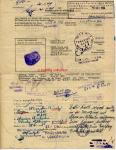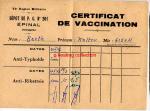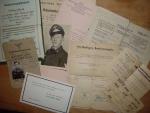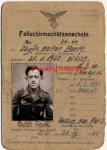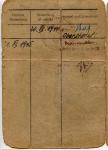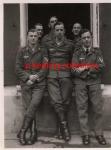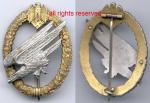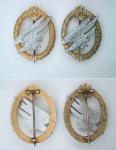-
Posts
2,284 -
Joined
-
Last visited
-
Days Won
6
Content Type
Profiles
Forums
Blogs
Gallery
Events
Store
Everything posted by PKeating
-
Not at all, Chris! Cloth badges were, as we know, unofficial tailorshop items tolerated by the authorities. In the case of the FSA, it was 'officialised' by the authorities as a morale-boosting interim measure to give newly-trained paratroopers something to show for their efforts when they graduated from jump school. Many young paras were being posted to frontline units and getting killed before their award documents and issue badges caught up with them, a process that could take weeks or even months if a unit was moving around a lot. So the OKL introduced these award documents and gave out cloth badges with them. Below is a photograph of another Class of '44 paratrooper, photographed on leave in Germany just after graduating from jump school in Serbia. Walter Hummel is wearing the cloth version of the Luftwaffe badge on his tunic. PK
-
He survived the war but died relatively young. Here's an interesting little chit charting his vaccinations as a PoW. So at one point, Walter Barth seems to have been a guest of the French. There again, perhaps he and his fellow Prisoners of War were merely taken to a French camp for their vaccinations. The Ricketts jab is quite telling, isn't it? He was discharged in 1948 by the British. PK
-
There are about sixty photos with his papers, mostly related to his Flak-Artillerie service. The only FJ-related photo is of an NCO with whom he served. He and his comrades clearly had neither the time nor inclination to take snapshots during and after the Normandy battles. There are some rather touching family photos, showing uncles and cousins in uniform, as well as BDM photos and an interesting Marine-HJ portrait from 1934. Anyway, there you have it: the life and death of a Son of the Fatherland.
-
Fallschirm-Sanit?ts-Abteilung 5 was part of 5. Fallschirmj?ger-Division, formed in Reims in March and April 1943 under the command of Generalleutnant Gustav Wilke, who would command the division until September 1944. 5. FJD was formed with III./FJR3, III./FJR4, the Fallschirm-Lehr-Bataillon as cadre and fresh recruits from various branches of the Luftwaffe, like Walter Barth. Finishing his parachute training at Dreux early in July 1944, it is reasonable to presume that Walter Barth transferred from the Flak at least six months previously so he would have been at Reims and then, perhaps, briefly in Brittany, the division having been posted to the Rennes area in May 1944, before he went to Fallschirmschule 1. As FJ historians and students know, the division was far from combat-ready on 6.6.1944 but was thrown into the fighting all the same, suffering very heavy losses. Look again at Walter Barth's face and compare this prematurely aged 24 year old to the smiling youngster with his mates in the Flak-Artillerie. Walter Barth survived Normandy and the retreat and was evidently with 5. FJD when it reformed around Amsterdam and The Hague in October and November 1944. The division fought in the Ardennes, the Harz Mountains and the Ruhr Pocket. The majority of the division surrendered at the N?rnburgring in March 1945, after the death of the divisional commander Ludwig Heilmann, who had taken over from Wilke in September 1944. The remaining Fallschirmj?ger of 5.FJD fought on under their new, nominal commander, Oberst Gr?schke before surrendering in the Ruhrkessel, with remaining elements going into the bag as the Allies rolled through the Harz Mountains.
-
The very, very rare late war cardboard FSS issued to Walter Barth, who would have been one of the last para-trained Fallschirmj?ger of WW2. By late July 1944, parachute training had been indefinitely suspended at all the schools in France (obviously!), Germany and Hungary. Walter Barth probably lost his soldbuch and other documents during the retreat from France as his FSS appears to have served as an ID document on which his promotion to Stabsgefreiter in January 1945 was recorded. Note also the entry for July 1945, closing off the document. This was when Barth and his surviving comrades from the rebuilt 5.FJD went into the bag. PK
-
Walter Barth was born on 21.1.1920. He did very well at school and was apprenticed at fourteen. Prior to joining the Fallschirmj?ger, he served with a heavy Flak unit in various places, including France. He was stationed at Le Bourget aerodrome on the north-western outskirts of Paris at one point. Here is a fresh-faced Walter with some of his mates. PK
-
You don't see these very often. Walter Barth and his mates must have able to hear the Allied guns as they completed their jump course at Dreux, to the west of Paris, in July 1944. There was another type of document for the Parachutists Badge in cloth, incorporating a counterfold - in other words, a folded A4 sheet - with an artist's portrait of the F?hrer. I am reliably informed that these were carefully removed by recipients and put to the appropriate use during morning ablutions. This is the simple A5 document. PK
-

Korinth EK2 photo caption
PKeating replied to PKeating's topic in Germany: Third Reich: Research, Documentation & Photographs
A close-up. Now, is it just a trick of the camera or are those collar patches blue, as worn by medics? The fellow who had this photo served with an 88mm Flak-Artillerie unit before transferring to the 5. Fallschirmj?ger-Division as a medic, where he presumably received this photograph as a souvenir from, obviously, the man pictured therein. PK -

Korinth EK2 photo caption
PKeating replied to PKeating's topic in Germany: Third Reich: Research, Documentation & Photographs
Here's the front. It's a very nice snapshot of a proud Korinthspringer just after receiving his EK2 for the canal jump. Crete was yet to come... I rather like the way the original print or negative appears to have been deformed at some point before this NCO made up these postcard version, presumably to give to family and friends, like the man from whose group this came. PK -

Heer Army Para by Juncker
PKeating replied to Stan's topic in Wehrmacht Medals, Decorations & Awards
Incidentally, the above Type 2b badge is for sale. See "Original Genuine Sales" elsewhere on this website. It is not advertised anywhere else. PK -

Heer Army Para by Juncker
PKeating replied to Stan's topic in Wehrmacht Medals, Decorations & Awards
And here is an original Type 2 FSA (Heer). This is the Type 2b with the thicker wreath but struck on the same dies as the Type 2a and, incidentally, the 1943/1944 badges in feinzink. PK -

Heer Army Para by Juncker
PKeating replied to Stan's topic in Wehrmacht Medals, Decorations & Awards
Here is another of these fakes, offered as original by a British dealer, side by side with a genuine 1957-pattern badge. The diving eagles are, as you can see, similar though not identical. The comparison supports the contention that the diving eagles on the type of fake in question were sourced from a firm producing 1957-pattern badges. This image came from an article by the dealer in question and I am posting it here under Fair Use provisions. PK -

Heer Army Para by Juncker
PKeating replied to Stan's topic in Wehrmacht Medals, Decorations & Awards
I am afraid that this is a type of fake first seen in the late 1960s and still offered as original by some dealers. These have caught a lot of people out. Some Type 2 aluminium Army Para Badges bore C E Juncker's stamp on the reverse of the diving eagle but it was quite different to this stamp, which is more like the stamp seen on some wartime Luftwaffe badges. Here's an extract from an article I wrote a while ago: The diving eagles appear to be well struck and are probably from a stock of 1957-pattern denazified Fallschirmsch?tzdenabzeichen but the wreaths are, as I said, cast. Have a look at how this fake compares to a known, original Type 2 aluminium badge. PK -

Republic of Ireland IRISH 1916 IRA SET On EBAY
PKeating replied to Kev in Deva's topic in Northern European & Baltic States
Fascinating information, Brendan! There is, by the way, no problem with resurrecting old threads if you have new information pertaining to the subject matter. You said what I hesitated to say, that it is actually very hard to ascertain the participation of someone in the 1916 Uprising, to say nothing of the War of Independence (aka Anglo-Irish War) and the Civil War. In rare cases where a veteran was known and there is supporting documentation, it is a different matter but what is to stop some intelligent, talented forger from creating 1916 groups from scratch, with original medals, when prices in excess of ?20,000.00 provide the incentive? I have seen very cleverly faked German WW2 Knight's Cross or elite unit groups bought by fairly experienced collectors who only found out by chance, because of some anomaly or error in the documents, spotted by an informed third party. With an Irish 1916 group, it would appear that one could fabricate a participant, using some genuine period letters, a pension book from the 1940s or 1950, an old driving licence, and a few other things, with a few additions and enhancements indicating that he was in Boland's or some such place during the fighting, along with a photo of a couple of old geezers wearing their 1941-issue medals, and a pair of original medals. Outlay? Well, prices have risen so the 1916 medal would cost a bit but let's say our forger lays out a total of three or four grand in cash, along with his time. The 400% to 500% profit makes it viable. As you so rightly point out, in addition, who can say if a man who genuinely received a medal or the two medals in the 1940s was a genuine veteran? In a few documented cases, where the chap was known and people attested to his participation, one can be sure but how many such cases are there? A lot of the real Men of 1916 never had medals. Nor did many of the fellows involved in the War of Independence and the Civil War. I knew many of them as a kid in Dublin in the 1960s. I remember one of them, at my parents' house in Upper Mount Street in 1966, just after the unveiling of the Wolfe Tone Memorial which my father designed, making sneering remarks about the massed ranks of "veterans" who turned up to hear Eamonn de Valera's speech. As far as he and his mates were concerned, they were what we now describe as "Walts". He was somewhat blunter in his terminology. And he was a Boland's veteran. He's in some of the news photos. He really "was there". Some idea of the strength and vehemence of their remarks can be gleaned from how clear my memory of it remains, even though I was just five years old at the time. Of course, as I grew older and more interested, I would ask them to tell me stories and, like all genuine veterans, they tended to steer clear of nasty stuff and "heroics". They preferred to remember the good times...but as good times were rather far and few between for them during the wars, they didn't have a lot to tell a young lad. One story Paddy - shan't give his surname here in case the medals he never bothered getting turn up at Whyte's! - told me concerned a young girl who turned up at Boland's asking for some bread, as all the bakers had closed up after selling out. The young girl was a great-aunt of mine by marriage and was able to confirm the incident. This is not to say that all applicants for these medals were Walts and poseurs. They certainly weren't. But an alarming number of these medals appear to have been handed out to bullsh1tters. It's rather like French Resistance medals. I'm sure that were one to sit, say, thirty recipients down in a room to fill out a questionnaire related to things any real veteran would know, many would fail it and not because of encroaching senility! They wouldn't be able to tell you, for example, how to load or field-strip the sort of weapons their units used. It's like all these fake paratroopers one meets: when you pose some simple questions, they flunk the test. It's too late to address the issue where these Irish medals are concerned but I think anyone contemplating the purchase of such medals should be very wary, especially in the aftermath of the Whyte's' sales. PK -

Republic of Ireland IRISH 1916 IRA SET On EBAY
PKeating replied to Kev in Deva's topic in Northern European & Baltic States
I concur with Paul. It looks perfectly OK but any example commanding a substantial price ought to have the top suspender. Gosh...I remember when one could pick these up in London antique markets for around ?15.00 or ?20.00. I think Ireland's escapist attitude to her looming economic troubles, some smart types with a talent for hype, the 90th anniversary and a rash of people with more money than sense caused the enormous hikes in prices. Interestingly enough, I approached Whyte's last year with a stone proof of a portrait of Sir Roger Casement, done in Dresden during Casement's last visit to Germany just before the Rising. The stone proof - a unique item - was done for a German propaganda book of the time and ended up in the collection of the director of the hotel where Casement stayed. Gustav R?cker collected autographs of some of the interesting people who stayed at the Europa Hof from the WW1 era to the 1930s and I have the collection. So, yes, the print appears to be signed by Casement. Whyte's estimate? About ?200.00. This was in the run-up to that Uprising sale. I had actually made a bet with a friend who was pushing me to cash in on the whole 90th anniversary hype that this would happen when I 'came from nowhere' and asked the auction house about this piece. Had I been a dealer or someone better-connected with them, I expect the estimate would have been somewhat higher. Not that I wish to cast aspersions. Maybe the chap at Whyte's failed to grasp the historical importance of the piece... But I won my bet, which I made on the basis of my highly jaded attitude to auctioneers in general. At the end of the day, far more of these medals were minted than ever awarded. Of course, a set with verifiable provenance and related ephemera will always have a substantial value, particularly if the recipient happened to be well known or well-connected. However, I would challenge $500-plus for an unattributable, incomplete War of Independence Service Medal. PK -

Luftwaffe Rare piece to be auctioned.
PKeating replied to jonightflyer's topic in Wehrmacht Medals, Decorations & Awards
106 honorific awards of the PO Badge in the nine months of 1943 up to September... Hmmmmmm. Regarding the question of a special solid gold PO Badge, one cannot discount it, given G?ring's penchant for expensive gewgaws. So far, we know that Otto Skorzeny received some form of flight badge because his SS personnel file confirms it and it is supported by anecdotal evidence. It is obvious that this must have been an honorary award of the Pilot-Observer Badge because, as far as I know, Skorzeny did not hold any form of pilot's licence. It is interesting that the awards on his funeral cushion include a rather normal-looking PO Badge. Had Skorzeny been a holder of the PO Diamonds Badge, this would surely have been included with the awards displayed, even if the original was lost, because replicas were available when Skorzeny died. The cuff title is a fantasy piece. I haven't found any evidence of an award of the Ehrenblattspange but that does not, of course, mean that he did not receive it. Skorzeny also held the SS Old Fighters' Chevron and the Reich Sports Badge in Silver. PK -

Luftwaffe Rare piece to be auctioned.
PKeating replied to jonightflyer's topic in Wehrmacht Medals, Decorations & Awards
Well-spotted, Chris. Must be all those aluminium messtins I ate from promoting premature senility! I've never seen a document for the Diamonds badge but yes, this document is for an honorary award of the Combined Pilot-Observer Badge and would tie in with Skorzeny's own recollection, when interviewed in the 1950s by Charles Foley, of receiving an honor award from G?ring at Rastenburg just after Gran Sasso. If the entry in Skorzeny's personnel file for the award of the "Fliegerabzeichen in Gold" on 1.12.1944 relates to the Combined Pilot-Observer Badge with Diamonds, then Hermann G?ring must have awarded it to Skorzeny for the coup d'?tat in Budapest, codenamed Unternehmen Panzerfaust. If so, it is ironic that the man Skorzeny toppled, and whose son he kidnapped, was a recipient of the PO Badge with Diamonds. Maybe Fat Hermann told Skorzeny he could have Admiral Horthy's badge... There again, why is the September 1943 honorary award of the PO Badge not included in his personnel file? Of course, many personnel files are remarkably incomplete when it comes to details like awards but Skorzeny's file doesn't appear to fall into this category. It is quite detailed. Is the award date an error? Was the badge to which the file refers just an honorary PO Badge? Did some smart alec decide to interpret this SS file entry as meaning that Otto Skorzeny was awarded the PO Badge with Diamonds, in order to pass a well-made fake onto the market? None of this is new. In a letter to a militaria magazine in 1981, as Chris relates in one of his books, Andrew Mollo expressed his belief that there was a third - solid gold - grade of the honorary PO Badge awarded to Heinrich Himmler. The above file was prepared by the staff of the RF-SS so perhaps they were in the habit of referring to the PO Badge, with or without the diamonds, as the "Fliegerabzeichen in Gold", because of the colour of the wreath. And perhaps this led to Mollo's theory that there could have been a third class of the badge. As for the Skorzeny award document, I would, as I said, have expected to see G?ring's embossed seal on a document of this kind rather than the ink stamp. I am not even sure that Skorzeny managed to hang onto any of his awards or paperwork. How much of the stuff on it was even original? Leaving aside his incarceration as a suspected war criminal, US and British security services turned his homes over several times in their frantic search for evidence to make the war crimes charges stick. Otto Skorzeny was considered the most dangerous man in Europe, especially in that delicate period after the war. When Skorzeny was sprung from prison, it is highly unlikely that he took anything incriminating with him on his escape to Spain. PK -

Luftwaffe Rare piece to be auctioned.
PKeating replied to jonightflyer's topic in Wehrmacht Medals, Decorations & Awards
That is logical. Wever and Milch died prematurely and their badges were probably returned to the Reichsmarschall's office. If these first three badges were made of superior metals - 916 gold - to later badges in 585 gold, it would be unsurprising that the pathologically acquisitive Hermann G?ring kept the Wever and Milch badges for himself, awarded slightly cheaper but just as beautiful A-St?ck badges in 585 gold instead, perhaps with white gold eagles. Regarding the question of platinum eagles, it should be borne in mind that platinum was indeed a precious metal but before the vast majority of stocks were reserved by the Space industry, it was seen as on a par with silver. It was popular for setting diamonds and other stones because of its relatively hard-wearing nature and resistance to oxidisation. Indeed, Tsarist Russia was using platinum for coinage well into the 20th century. Platinum as an exotic material is a comparitively recent phenomenon. It is 'rare' for the reason that diamonds are 'rare', because supply is highly controlled. If none of the eagles of known originals bear platinum hallmarks, I would suggest that this is because they were actually made from white gold and the view was taken that a single hallmark would suffice. In support of this, I would refer to two-piece badges struck in silver for private purchase by C E Juncker, like the Pilots Badge and the Army Parachutist Badge. These bear just one silver mark. I expect that if examined, the A-St?ck badges were made of yellow and white gold to achieve the two-colour effect. PK -

Luftwaffe Rare piece to be auctioned.
PKeating replied to jonightflyer's topic in Wehrmacht Medals, Decorations & Awards
That's a perfectly reasonable question, Stan. The ELSuB was a state award and requests for duplicates were made in the same way that any Ritterkreuz-related request was made after the rules regarding supply of the RK and its various "add-ons" were tightened in 1941. The Combined Pilot-Observer Badge with Diamonds was, however, a personal award instituted by Hermann G?ring and the A-St?ck award badges remained the property of G?ring's office, the rules requiring return of the badge when a recipient died. I think the families would have been allowed to keep the silver-gilt B-St?ck badge. At a stretch, one can envisage certain recipients, such as foreign royalty, nobility and heads-of-state commissioning copies of the badge from local jewellers but why would they bother? They did not as a general rule, as far as I am aware, commission copies of other orders and decorations. Furthermore, G?ring anticipated the need to take good care of the A-St?ck badges by giving recipients the silver-gilt dress copies. If Italian, French or Bulgarian recipients had done so, I am sure there would be a general awareness of variant badges bearing the appropriate hallmarks of the countries in question. Were a badge lost, I daresay that a recipient could request a replacement but, as you say, there does not seem to be any documentary evidence available in relation to this. Making such a request would have been rather embarrassing and might even have resulted in a hefty invoice. You contend that one recipient had three A-St?ck badges in his possession. If this individual managed to get three such badges out of G?ring's office, he must have been important enough to get away with two reports of losing the highly valuable insignia with which he had been trusted! So, who was he? A German recipient unfortunate or careless enough to lose his A-Stuck badge might have been tempted to have a replacement made but this brings us back to the question of whether any jeweller in the Reich or its territories would want to involve himself in replicating an award in the personal gift of the Reichsmarschall. Unofficial or semi-official though the award was, it was still G?ring's 'territory', so to speak. Moreover, G?ring was known to take a keen interest in the quality of awards, as the anecdote about the ELSuB in Adolf Galland's memoirs, for instance, tell us. In fact, it is surprising that G?ring countenanced the setting of the B-St?ck badges with rhinestones. I have handled a couple of A-St?ck badges but never handled a genuine B-St?ck badge so cannot comment on the quality of the stones therein. I suppose the point I have been leading up to is that private jewellers' copies of Third Reich awards tend to be postwar rather than wartime confections. There are exceptions, of course, like the EL commissioned from a Milan firm by General der Fallschirmtruppe Richard Heidrich but even then, Heidrich seems to have ensured that he had, at least, tacit approval from HQ for this. Japanese-made Iron Crosses are another example of legitimate wartime "jewellers' copies" but they were commissioned by the German authorities in Japan, presumably with the necessary permission to do so. I don't think one can explain away all these different-looking diamond-studded gold and platinum PO Badges to people like Milch, Sperrle, Skorzeny, Horthy and anyone else the fakers think of by saying that they could be wartime jewellers' copies. No Luftwaffe General would have dared to wear an unapproved replica of an award from their sharp-eyed boss! PK


